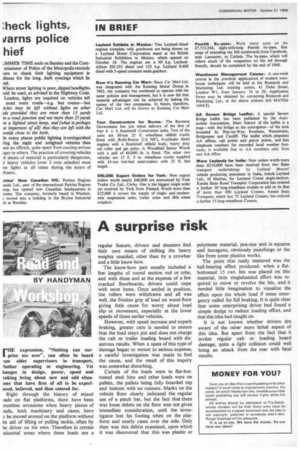A surprise risk
Page 50

If you've noticed an error in this article please click here to report it so we can fix it.
regular feature, drivers and shunters find their own means of shifting the heavy weights unaided, other than by a crowbar and a little know-how.
The know-how part usually included a few lengths of round section rod or tube, and with these and at the expense of a few cracked floorboards, drivers could cope with most items. Once settled in position, the rollers were withdrawn and all was well, the friction grip of load on wood floor giving little cause for worry about load slip or movement, especially at the lower speeds of those earlier vehicles.
However, with speed increase and superb braking, greater care is needed to ensure that the load stays put and does not charge the cab or trailer loading board with disastrous results. When a spate of this type of damage began to mount to serious expense, a careful investigation was made to find the cause, and the result of this inquiry was somewhat disturbing.
Certain of the loads were in flat-bottomed steel bins and other loads were on pallets, the pallets being fully boarded top and bottom with no runners. Marks on the vehicle floor clearly indicated the regular use of a pinch bar, but the fact that there was loose debris on the floor was not given immediate consideration, until the investigator lost his footing when on the platform and nearly came over the side. Only then was this debris examined, upon which it was discovered that this was plastic or
polythene material, pea-size and in squares and hexagons, obviously punchings or the like from some plastics works.
The point that really mattered was the ball-bearing effect produced: when a flatbottomed 15 cwt. bin was placed on this material, little singlehanded effort was required to move or revolve the bin, and it needed little imagination to visualize the effect upon the whole load if some emergency called for full braking. It is quite clear that some enterprising driver had found a simple dodge to reduce loading effort, and that this idea had caught on.
It is not known whether drivers eire aware of the other more lethal aspect of this idea. But apart from the fact that it invites regular cab or loading board damage, quite a light collision could well bring an attack from the rear with fatal results.












































































































































